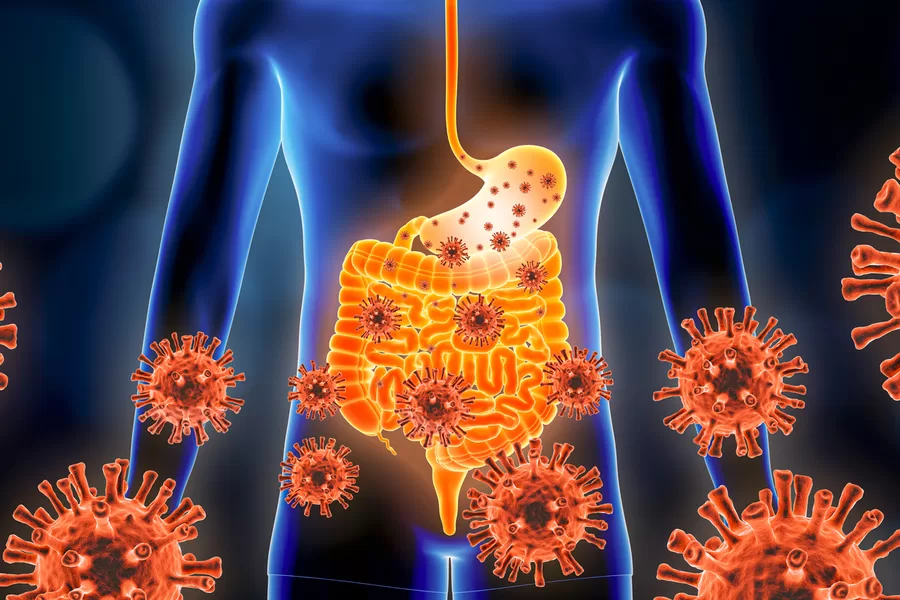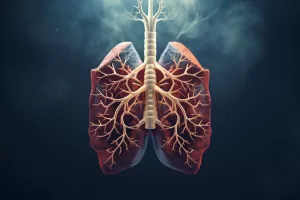According to WHO estimates, more than 500 million people suffer from digestive system infections every year. The main reasons for the wide spread of such infections are the increase in the spectrum of infectious microorganisms, the growing importance of endogenous and exogenous factors that contribute to the increase in the virulence properties of opportunistic flora.
Read this article to learn more about popular digestive system infections, their course, and treatment.
What is Digestive System
The digestive system is responsible for digestion. It includes organs that carry out the mechanical and chemical processing of food products, the absorption of processed and the release of undigested components.
The human alimentary canal is divided into the following parts:
- Oral cavity;
- Pharynx;
- Esophagus;
- Stomach;
- Small and large intestine.
The digestive system also includes large digestive glands – the liver and pancreas, parotid, sublingual, and submandibular salivary glands with ducts opening into the lumen of the alimentary canal.
How the Digestive Process Works
Digestion is a complex of mechanical and biochemical processes that occur in the gastrointestinal tract and are necessary for the processing and assimilation of food. It requires a lot of energy and starts in the mouth during chewing.
The chewed food is swallowed. It passes through the esophagus and reaches the stomach where proteins are broken down by the action of gastric juice. But the digestive process in the stomach is not limited to chemical digestion (acid denaturation of proteins). There is also a mechanical component represented by peristalsis.
From the stomach, food enters the small intestine. Numerous enzymes are released there to carry out further breakdown of food components. After that, food enters the large intestine, which absorbs the remaining nutrients and water. The resulting fecal material is stored in the rectum, from where it is expelled during defecation.
Role of Gut Flora
The gut flora is a combination of various microorganisms characterized by certain species composition and occupying a particular biotope in the body. In fact, it plays a very important role in the digestive system and immunity, performing a number of important functions:
- Protective. The gut flora prevents the colonization of the gastrointestinal tract by pathogenic microorganisms such as Shigella, Salmonella, Enteropathogenic E. Coli, etc.;
- Digestive. Proteins, fats, and carbohydrates that are not cleaved in the small intestine are subjected to enzymatic cleavage under the influence of the normal microflora of the large intestine;
- Motor. The microflora contributes to the regulation of intestinal motility;
- Absorption. The microflora promotes water absorption;
- Detoxification and anticarcinogenic. Some substances produced by bacteria have antioxidant properties and help reduce the risk of colon cancer;
- Synthetic. The intestinal flora provides the synthesis of many vital substances, including B vitamins, folic, nicotinic acid, etc.;
- Immunomodulatory. The gut flora is involved in the formation of both local and general immunity.
What is a Digestive System Infection
Digestive tract infections are a polyetiological group of infectious diseases of different etiology, characterized by impaired motility of the gastrointestinal tract with the development of diarrhea, intoxication, nausea vomiting, and dehydration.
Digestive infections are the second most common after acute respiratory viral infections. In the general structure of intestinal infections, children account for 60-65% of all diseases, while a significant share falls on the younger age group (0-1 year). This is due to the anatomical and physiological features of the digestive organs and the imperfection of protective mechanisms and sanitary-hygienic skills of the child. The negative impact of this pathology is especially pronounced in young children. The disease leads to malnutrition, decreased immunity, dysbiosis (dysbacteriosis), and secondary pancreatic insufficiency.
Types
There are three main causes for intestinal infection development:
- Bacteria;
- Viruses;
- Parasites.
Accordingly, gastro intestinal infection can be bacterial, viral, or parasitic. A brief description of each type is presented in the following paragraphs.
Bacterial
A bacterial infection of the digestive system is a disorder caused by bacterial pathogens (Shigella, Salmonella, Vibrio cholerae, Staphylococcus, Escherichia, Brucella, Clostridia, etc.), which produce toxins leading to body poisoning.
Viral
Viral infection digestive system is a group of diseases caused by viruses that attack the mucous membrane of the stomach and intestines and are usually accompanied by indigestion, abdominal pain, diarrhea, vomiting, and intoxication of the body. Enterovirus and rotavirus are the most common causative agents of viral intestinal infections.
Parasitic
Parasitic digestive system infections are caused by protozoa. The most common are Amoebiasis (the causative agent is an amoeba) and Giardiasis. Routes of infection are usually food and water.
Symptoms
There are several important symptoms indicating that a person is contaminated. If you have such symptoms, you should contact a doctor as soon as possible, take appropriate blood tests, and undergo treatment.
Abdominal Pain and Cramps
Abdominal pain and cramps are the most common digestive system infection symptoms. They can be caused by various types of intestinal infections, especially bacterial ones. Long-term cramps require a visit to the hospital to restore the body’s health.
Diarrhea
Entering the digestive tract, bacteria, viruses, or parasites can cause diarrhea. It is worth remembering that such a condition is dangerous for a person because it can lead to dehydration and other serious consequences.
Nausea and Vomiting
This is also a fairly common symptom indicating that a person is infected. It is usually quite unpleasant and therefore requires a quick response. If nausea and vomiting do not go away within a few hours, it is imperative to consult a doctor about further actions.
Bloating and Gas
There are two main complaints that are characteristic of excessive accumulation of gas in the gastrointestinal tract: excessive belching and bloating. Helminths are often the cause of the symptom.
Blood or Mucus in Stool
Blood and mucus in the stool is a symptom of inflammation. If it is accompanied by diarrhea, the likelihood of an intestinal infection is high.
Common Digestive System Infections
Common digestive system infections include viral gastroenteritis, gastritis, colitis, diverticulitis, salmonellosis, norovirus, and rotavirus.
Gastroenteritis
Inflammation of the intestinal mucosa and stomach is called gastroenteritis. The disorder can be caused by bacteria, parasites, and viruses. The incubation period is up to 5 days. Bacteriological and virological tests are usually performed to identify the pathogen. Symptomatic signs are nausea, vomiting, diarrhea, stool disorders, abdominal pain, and an increase in body temperature.
Gastritis
Gastritis is an inflammation, irritation, or erosion of the mucous membrane of the stomach. Its causative agent is the bacterium Helicobacter pylori. The first signs of gastritis are abdominal pain, heartburn, nausea, and loss of appetite. Gastritis can have very individual manifestations, and in some cases, it is almost asymptomatic.
Colitis
According to the EFCCA, about 10 million people in the world suffer from colitis. This is a non-specific inflammatory bowel disease characterized by periods of exacerbation. It most often develops at the age of 20-40 years. Escherichia coli is usually the causative agent of infectious chronic colitis.
Diverticulitis
Diverticulitis is an inflammatory process in the intestine resulting from bacterial growth or infection in the diverticula. Clinical signs of diverticulitis include intense pain in the lower abdomen on the left, blood and mucus in the stool, fever, flatulence, nausea, vomiting, and rapid heartbeat.
Salmonella
Salmonellosis is one of the acute gastrointestinal infections caused by Salmonella bacteria. It is usually accompanied by diarrhea, intoxication, and dehydration. In complicated cases, it leads to the development of abscesses of internal organs and sepsis.
Norovirus
Norovirus is an intestinal infection caused by the Norwalk virus, which refers to RNA-containing microorganisms. The infection is transmitted from people with acute signs of norovirus and from asymptomatic carriers. The incubation period is 1 day, in rare cases – 2 days. Symptoms: diarrhea, intoxication of the body, vomiting.
Rotavirus
Rotavirus is an infectious disease that affects the mucous membranes of the oropharynx and small intestine. It is very spread in the cold season. Children aged 6 months to 4-5 years are most often affected. The incubation period is up to 1 week. Characteristic symptoms are an increase in body temperature, nausea, abdominal pain, vomiting, diarrhea, runny nose, and sore throat.
Treatment
Rehydration, medication, and probiotics play a key role in the treatment of gastrointestinal infections.
Rehydration
Oral rehydration is one of the main treatments for acute intestinal infections. It is aimed at restoring the water and electrolyte balance in the body, which is disturbed due to the loss of fluid and electrolytes during diarrhea and vomiting.
Medication
Most intestinal infections (for example, yeast infection digestive system) need to be treated with medicines. The doctor usually prescribes enterosorbents, intestinal antiseptics, intestinal antibiotics, antiparasitic drugs, antiviral drugs, etc.
Probiotics
Probiotics are an adjunct in the treatment of digestive system infections. These are living microorganisms that directly affect human health and aim to provide favorable conditions in the gastrointestinal tract. Most often, probiotics include lactobacilli and bifidobacteria.
Summary
Digestive tract infections remain one of the most serious problems of modern infection science. They are characterized by a wide distribution and a high frequency of complications that pose an immediate threat to life. Therefore, it is important for everyone to know how such a health condition manifests itself, how to avoid it, and in which cases an immediate consultation with a doctor is needed.
FAQ
What are some infections in the digestive system?
Gastroenteritis, Gastritis, Colitis, Diverticulitis, Salmonella, Norovirus, and Rotavirus are the most common digestive system infections.
How do you know if you have an infection in your digestive system?
You need to contact a doctor and pass the necessary test on his advice.
What causes infection in the digestive system?
Infection in the digestive system is usually caused by bacteria, viruses, or parasites.
What are the symptoms of a bacterial gut infection?
A number of symptoms point to a bacterial gut infection, including abdominal pain and cramps, diarrhea, nausea and vomiting, bloating and gas, blood or mucus in stool.






